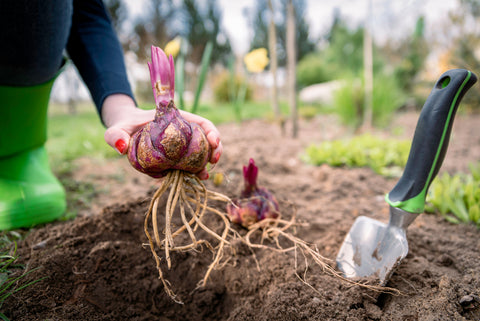
About Lilies
Lilium is a type of herbaceous flowering plant growing from bulbs, all with large prominent flowers. Lily plants come in an abundance of colours and types. From exotic looking lilies with painted petals, speckled in both light and dark dots, to elegant white lilies that shine with pure white petals and red stamens. All lilies share the same basic, elegant look. Comprising of large, wonderful coloured triangular petals that open wide and curl back to showcase the delicate stamen in the center of the bloom.
Asiatic Lilies are fragrance free whilst Oriental Lilies boast incredible fragrance!
The Basics
It is important to consider the bloom time when selecting varieties of lilies.
Asiatic Lilies bloom in early to midsummer, whilst Oriental Lilies bloom in mid to late summer. Many gardeners choose to plant both to enjoy lily flowers all summer long. It is important to take into account the lilies’ mature height. Border Lilies grow 14-18 inches tall, while Oriental Lilies are usually 3-4 ft tall. Giant Lilies can reach 6-8ft tall. Now, you can narrow down your color preferences and choose from a large variety of pink, orange, red and many more!
Planting lilies in combination with other plants will give your garden splashes of colour all summer long with minimal maintenance. Regardless of whether you choose Asiatic Lilies that are fragrance free and bloom in midsummer, or very fragrant Oriental Lilies that bloom in mid to late summer.
Bulb Storage Before Planting
After you’ve received your order and inspected it, keep the exterior carton and the inner boxes open to give the bulbs some air. All bulbs love good air circulation. Store them in a cool, dry place with low humidity, away from heat, frost and strong sunlight at about 50°F to 70°F. Never put flower bulbs in the freezer! Poor storage conditions could cause bulbs to dry out, or to become moldy.
When Do I Plant Lily Flowers?
Lily bulbs can be planted in fall or early spring. Plant in early spring when the ground is workable but not muddy. Plant in the spring in well-drained, compost enriched soil. If planting in the fall it is important to do so at least four weeks prior to your last frost date in order that they can put down strong roots before the ground freezes.
Lily bulbs may be planted in spring or fall, for blooms in mid to late summer. However, most commercial growers don’t harvest their lily bulbs until the very end of the growing season. This can make it a challenge to get the bulbs that come from Holland delivered in time for fall planting. Instead, the bulbs are usually stored in coolers for the winter and are shipped in time for spring planting.
How To Plant Lilies
- For best results, plant your lilies where they will have a mix of some leaf mold or compost in the soil. Lilies prefer to have their blooms in the sun and their roots in the shade. Try planting them among annuals or perennials that will keep their roots cool.
- Plant with the roots downward and the scales upward with their tops 4–6″ below the soil surface and the slightly pointy end facing up. After planting, water well two or three times before freezing. Lilies are most effective when planted in groups of three or more. Space them about a foot apart – they will spread and fill this space in no time!
- For container planting, choose a container with adequate drainage holes that’s large enough to accommodate your plant’s mature size and fill it with good quality, well-drained soil. Dig holes and plant your Lilies close to each other with hips roughly 4″ apart. Tuck them down 4–6″ inches into the soil with the bulbs’ pointy part facing upwards.
- Water thoroughly, soaking the soil to settle it around the bulbs.
Aftercare for Lilies
- Water as needed during the active growth periods. Around 1″ of moisture per week is a fair estimate.
- It is advised to apply mulch around the plant to keep the roots cool and moist, but not wet, during active growth.
- Apply a high-potassium fertilizer every couple of weeks from planting until roughly 6 weeks after flowering.
- Leave the foliage in place after blooming has finished for the season. The leaves will gather sunlight to create food through photosynthesis, strengthening the bulb for the future.
- Remove foliage and decrease watering when the leaves turn yellow and die back as your Lilies slip into dormancy.
Lily blooms typically stay vibrant for at least two weeks, frequently longer. The plants themselves can be quite long-lived. As long as your plants are hardy to your climate zone, they’ll come back annually for years.

